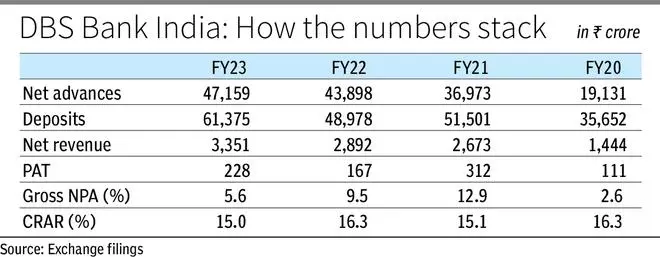When DBS converted its Indian operations into a wholly-owned subsidiary, it ushered in the second innings for the foreign bank in the country. Since 2019, it had been scouting for inorganic opportunities. It even engaged with the regulator to rescue a few failing banks before 2020.
A year later, an opportunity presented itself in the form of Lakshmi Vilas Bank (LVB). It took over LVB at almost no cost and on a clean slate in November 2020. But the integration, which concluded in December 2022, was a long journey. In hindsight, it was possibly a pain worth going through, given the way DBS is transforming itself from a digital bank to one with a significant physical presence.
The amalgamation brought with it a deposit base of ₹18,823 crore, net advances of ₹10,685 crore, and a network of 563 branches and about 970 ATMs. Post-rationalisation, DBS Bank India has 530 branches across 19 States, including its organic network of 35 branches.
In FY21, owing to the merger, DBS Bank India incurred a pre-tax drag of ₹341 crore, and ₹669 crore in FY22, impacting the bank’s profitability. Its gross NPA ratio deteriorated significantly to 12.93 per cent, though on expected lines, given that weak asset quality was among the key reason for LVB’s collapse.

recovery mode
The clean-up ensued a capital infusion of ₹2,500 crore from DBS Bank, the parent entity. Since then, it has been on a recovery mode. FY23 net profit at ₹228 crore (year-on-year growth of 37 per cent) and gross NPA ratio at 5.6 per cent present a decent picture.
Given that much of the physical presence inherited from LVB is in the southern States, the lender has shifted its business strategy to focus on gold loans, affordable housing and MSME lending, in addition to the staple personal loan products. Gold loans, a segment that no other foreign bank has ventured into, is a ₹4,500-crore book, which DBS plans to grow to ₹15,000 crore over the next five years.
Deposit mobilisation is also gathering pace, with DBS Bank India’s deposits up by 25 per cent year-on-year in FY23. This overtakes 10 per cent growth in consumer assets seen by the bank. Retail loans account for 35 per cent of DBS India’s total loan book; up from 10 per cent in the pre-LVB days, and has about 10 lakh digibank accounts.
It has also roped in HSBC’s former head of commercial bank Rajat Verma as MD and Head of Institutional Banking.
DBS India is justifying it’s LVB acquisition. Aided by its Asian roots and a 29-year track record in India, DBS Bank seems to have demonstrated a better understanding of the dynamic Indian market and the need to adapt according to local demographics and domestic lending requirements. It is one of the few foreign banks positioned to compete with domestic private sector banks — something Citibank, FirstRand Bank, UBS, Morgan Stanley, Deutsche Bank and Barclays have struggled to do in the past.
The focus now will be to grow the CASA deposits to 40-45 per cent from 31-32 per cent, and increase the share of retail deposits to 65-70 per cent from the present 45 per cent mark. On the lending side, in 3-5 years, DBS is aiming to increase the share of consumer and SME loans to 70 per cent from the current 30-40 per cent levels. Like most private banks, DBS also has its eyes on unsecured loans, credit cards, growing the NRI and HNI clientele, and alternative revenue streams such as wealth management and bancassurance.
While NPAs have moderated since FY21, the bank is only mid-way on this journey. Yet, despite having come quite far, DBS and LVB remain synonymous for many of us. Can the Singapore-headquartered bank break this image? It may take another 12-15 months to completely shed the impact of the acquisition on profitability, the distribution network and retail customer base. But what about its brand image? That should equally be a focus for DBS.
A successful business model could then prove to be the exception to the rule for India’s foreign bank story.







Comments
Comments have to be in English, and in full sentences. They cannot be abusive or personal. Please abide by our community guidelines for posting your comments.
We have migrated to a new commenting platform. If you are already a registered user of TheHindu Businessline and logged in, you may continue to engage with our articles. If you do not have an account please register and login to post comments. Users can access their older comments by logging into their accounts on Vuukle.